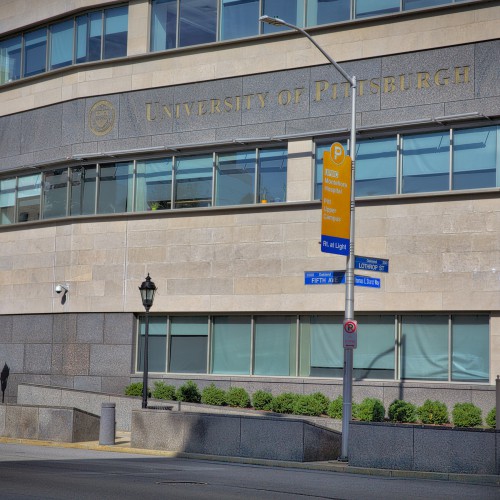
Tim Greenamyre, MD, PhD
Love Family Professor & Vice-Chair of Neurology
Chief, Movement Disorders Division
Director, Pittsburgh Institute for Neurodegenerative Diseases
E-mail
Interests
Currently, treatments for neurodegenerative diseases are inadequate; they typically address symptoms rather than the underlying degenerative process. As a result, we have no way to alter the inexorable progression of these devastating illnesses. My lab is interested in defining mechanisms of neurodegeneration in order to identify new targets for development of neuroprotective (‘disease-modifying’) therapeutic strategies. Most of our current work is on Parkinson’s disease (PD), and we are particularly interested in mitochondrial abnormalities and their roles in causing oxidative damage, protein aggregation and neurodegeneration.
About 90% of PD cases do not have a clear genetic cause and are therefore called ‘sporadic’ or ‘idiopathic’ cases. However, a large number of genetic mutations have been identified which can result in relatively rare inherited forms of the disease – and there are still other mutations which may not cause the disease, but greatly increase the risk of developing PD. Identification of such mutations has provided crucial clues about potential mechanisms that we are currently pursuing. We are particularly interested in the biological interactions between environmental exposures and genetic factors that increase disease risk.
Among other approaches, we are examining the potential benefits of ‘gene therapy’ approaches. Autosomal dominant mutations are generally thought to produce a detrimental ‘gain-of-function’ for the affected protein, so the general approach is to reduce expression of those harmful proteins. On the other hand, autosomal recessive mutations are associated with a loss of function, so in this instance, we attempt to increase expression of the wildtype (normal) protein.
We are also working to develop ‘biomarkers’ of PD, using blood samples, that will help us determine whether neuroprotective, disease-modifying therapies are doing what they are designed to do.
The lab uses a wide range of techniques that include molecular biology, protein chemistry, immunocytochemistry, cell culture, live-cell imaging, behavioral testing and stereotactic surgery. Some work involves human tissue specimens.
Previous trainees have obtained tenured faculty positions, as well as jobs in Pharma and in disease-related foundations, such as the Michael J Fox Foundation.
Training
| BS | Microbiology | Michigan State University | 1977 |
| PhD | Neuroscience | University of Michigan | 1986 |
| MD | Medicine | University of Michigan | 1986 |
| Resident | Neurology | University of Michigan | 1990 |
Positions Held
| Assistant - Associate Professor | University of Rochester | 1990-1995 |
| Associate - Full Professor | Emory University | 1995-2005 |
| Professor & Director | University of Pittsburgh | 2005- |
Honors and awards
Medical Scientist Award, University of Michigan Medical School (1986)
Best Doctors in America (1994)
Medical/Scientific Advisory Committee Huntington’s Disease Society of America (1994-2004)
Scientific Advisory Board, Dystonia Medical Research Foundation (1995-98)
Mallinckrodt Scholar (1994-97)
Chair, Grants & Fellowships Program, Huntington’s Disease Society of America (1998-2003)
Ottorino Rossi Award and Medal of the University of Pavia, Pavia, Italy (2000)
Scientific Advisory Board, Parkinson Study Group (2001-2008)
Scientific Advisory Committee, Michael J. Fox Foundation (2001-present)
Scientific Committee, Telethon-Italy (2002-05), Chair, Scientific Advisory Committee, Parkinson Study Group (2004-08)
Team Hope Award for Medical Leadership, Huntington’s Disease Society of America (2003)
Presidential Lecture, Annual Meeting of the SfN (2004)
Editor-in-Chief, Neurobiology of Disease (2004-present)
Executive Committee, Michael J. Fox Foundation (2005)
Chair, NINDS Special Emphasis Panel: ZNS1 SRB-G 04: ‘Cell biology of Parkinson’s disease’ (2005)
SFN Grass Traveling Lecturer, Omaha, NE (2005)
Langston Award, Michael J. Fox Foundation (2007)
Best Doctors in America (2007-present)
NOMD Study Section, NIH (2010-14; Chair, 2012-14)
Executive Committee, Michael J. Fox Foundation (2013-15)
Editor-in-Chief, MedLink Neurology (2013-present)
Elected, American Association of Physicians (2015)
Co-Chair, Gordon Research Conference on Parkinson’s disease (2015-17).
Gallery
Selected Publications
Sanders LH, Laganiere J, Cooper O, Mak S, Vu BJ, Huang YA; Paschon D, Vangipuram M; Sundararajan R, Urnov F, Langston JW, Gregory P, Zhang HS, Greenamyre JT*, Isacson O, Schule B, LRRK2 mutations cause mitochondrial DNA damage in iPSC-derived neural cells from Parkinson's disease patients: Reversal by gene correction, Neurobiol Dis 62:381-6, 2014.
Sanders LH, McCoy J, Hu X, Mastroberardino PG, Dickinson BC, Chang CJ, Chu CT, Van Houten B, Greenamyre JT Mitochondrial DNA damage: molecular marker of vulnerable nigral neurons in Parkinson’s disease, Neurobiol Dis 70:214-223, 2014.
Zharikov A, Cannon JR, Tapias V, Bai Q, Horowitz M, Shah V, El Ayadi A, Hastings TG, Greenamyre JT, Burton EA, shRNA targeting α-synuclein prevents neurodegeneration in a Parkinson’s disease model, J Clin Invest 125:2721-35, 2015.
Di Maio R, Barrett PJ, Hoffman EK, Barrett CW, Zharikov A, Borah A, Hu X, McCoy J, Chu CT, Burton EA, Hastings TG, Greenamyre JT. α-Synuclein binds to TOM20 and inhibits mitochondrial protein import in Parkinson's disease. Sci Transl Med 2016;8:342ra78.
Sanders LH, Paul KC, Howlett EH, Lawal H, Boppana S, Bronstein JM, Ritz B, and Greenamyre JT, Base excision repair variants and pesticide exposure increase Parkinson’s disease risk, Toxicol Sci 158:188-198, 2017.
Howlett EH, Jensen N, Belmonte F, Zafar F, Hu X, Kluss J, Schüle B, Kaufman BA, Greenamyre JT and Sanders LH, LRRK2 G2019S-induced mitochondrial DNA damage is LRRK2 kinase-dependent and inhibition restores mtDNA integrity in Parkinson’s disease, Human Mol Genet 26:4340-4351.
Di Maio R, Hoffman EK, Rocha EM, Keeney MT, Sanders LH, De Miranda BR, Zharikov A, Van Laar A, Stepan A, Lanz TA, Kofler JK, Burton EA, Alessi DR, Hastings TG, Greenamyre JT, LRRK2 activation in idiopathic Parkinson disease, Sci Transl Med., 10, eaar5429 (2018) doi: 10.1126/scitranslmed.aar5429.
De Miranda BR, Rocha EM, Bai Q, El Ayadi A, Hinkle D, Burton EA and Greenamyre, JT, Astrocyte-specific DJ-1 overexpression protects against rotenone-induced neurotoxicity in a rat model of Parkinson's disease, Neurobiol Dis, doi: 10.1016/j.nbd.2018.04.008.
Van Laar VS, Arnold B, Howlett EH, Calderon MJ, St Croix CM, Greenamyre JT, Sanders LH, Berman SB (2018) Evidence for compartmentalized axonal mitochondrial biogenesis: Mitochondrial DNA replication increases in distal axons as an early response to Parkinson's disease-relevant stress. J Neurosci. doi: 10.1523/JNEUROSCI.0541-18.2018.
Lab Members
-
Roberto Di Maio
Assistant Professor
rod16@pitt.eduDr. Di Maio’s research focuses on defining the oxidative stress-related mechanisms of neurodegeneration. Using in vitro and in vivo experimental models of neuronal damage, his main goal is to assess the pathogenic pathways as potential targets for novel therapeutic approaches aimed at the prevention and/or cure of neurodegenerative disorders, such as Parkinson’s disease and epilepsy.
-
Emily Rocha, PhD
Assistant Professor
rochaen@upmc.eduThe overarching goal of my research is to examine whether LRRK2 and GBA are central to endosomal trafficking deficits and lysosomal dysfunction in Parkinson’s disease. I use a variety of techniques to study the mechanism(s) by which deficits in endosomal trafficking and lysosomal dysfunction cause accumulation of endogenous -synuclein and neurodegeneration.
-
Matt Keeney, BS
PhD Student
MTK30@pitt.eduMy research focuses on understanding how oxidative stress and Parkinson’s Disease-related dopamine dysmetabolism contribute to the progression of the disease. By gaining a clearer insight on how these cellular stresses affect and modify proteins, novel therapeutic strategies and targets can be more accurately developed. Utilizing specific cellular and immunohistochemical techniques I am developing a new blood-based biomarker which will aid in (1) early diagnosis of Parkinson’s and (2) determine if current treatment is effective.


